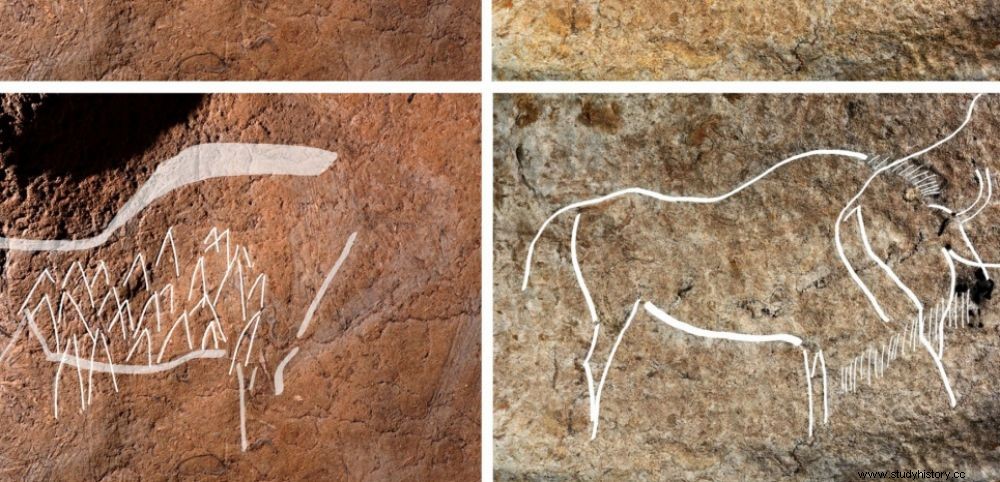 Rock engravings discovered in the cave of Atxuraa, in the Spanish Basque Country. Among the prehistoric bestiary, many bison, including one pierced by jet weapons (bottom left). Difficult to read, the engravings have been digitally underlined in white.
Rock engravings discovered in the cave of Atxuraa, in the Spanish Basque Country. Among the prehistoric bestiary, many bison, including one pierced by jet weapons (bottom left). Difficult to read, the engravings have been digitally underlined in white. BESTIARY. It took a very sharp eye! Spanish speleologists have indeed discovered, when they were barely visible, nearly 70 unknown prehistoric figures - horses, deer, or even bison - on the walls of the cave of Atxurra, in the Spanish Basque country. This extraordinary Paleolithic art gallery is located in the depths of a cavern located in Berriatua, 50 kilometers from Bilbao, not far from the small seaside town of Lekeitio.
Although known to scientists since 1929, no one had ever noticed this bestiary in the bowels of the cavity. And for good reason. Its dangerous access had made it inaccessible to visitors and only a few cavers had recently received permission to venture there. This is how exploration and research work started in 2014 to assess the potential of the site, led to the identification of these delicate engravings distributed over a hundred meters. The archaeologist Diego Garate and the speleologist Inaki Intxaurbe brought to light, more than 300 meters from the entrance to the cave, after a laborious progression - crossing long catholes and sheets of water -, this series of animal engravings executed it seems more than four meters from the ground, in the middle of a tangle of complex lines that are difficult to interpret. Detected in reality as early as September 2015, the discovery of these distant testimonies has only been announced these days.
 Among the parietal works found in the Atxurra cave, many horses. ©Provincial Council of Vizcaya
Among the parietal works found in the Atxurra cave, many horses. ©Provincial Council of Vizcaya
According to the first studies, it would be horses, deer, aurochs, hybrid creatures, and especially bison. One of them is also represented riddled with numerous throwing weapons. "This region of the Iberian Peninsula is very rich in decorated caves. Not far from the new site, in Gipuzkoa, the cave Altxerri, in the town of Aya, where there are also representations of bison, had already delivered nearly 179 Palaeolithic figures" , said prehistorian Jean-Loïc Le Quellec, research director at the CNRS. During a press conference given in Bilbao, Basque archaeologists estimated that the achievements of Atxurra could date back to 14,000 years, and therefore belong to the so-called Magdalenian period. The analysis of the decorated cavity, now totally protected, will continue, including using 3D digital imaging techniques. A three-year scientific project has been programmed.
